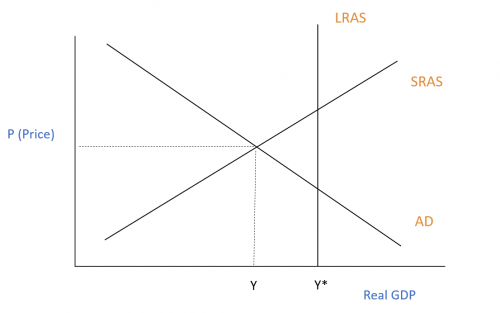Short-run: Involves expansions and contractions
Long-run: Shows increases in GDP
The Short-run Business Cycle
Aggregate Expenditure Model

- Assume – when there are output gaps, in the short-run, firms change output, not prices (menu costs like advertising, packaging, legal) – Keynes
- When Y does not equal PAE, there is an output gap (i.e. expenditure/demand is not met by anticipated demand)
- Firms change output by affecting the level of inventory they hold.
- In the short run, output changes; in the long run, prices change
Inventory
- IP – Planned Investment
- I – Actual Investment. If expenditure by consumers decreases, inventory held increases and investment (purchase of inventory) increases.
- The difference is the change in output that firms make instead of prices
Consumption, savings and investment
- C = exogenous C + c(Y-T)
- Consumption is both dependent on income and net government transfers, and exogenous consumption
- S=I
- Savings equals investment in a closed economy
Fiscal Policy
- Governments can influence output through G, T and t (government spending, transfers and taxes)
- To reduce a contractionary gap, increase G or reduce T
- Automatic stabilisers – reduction of Y means less taxes and more transfers (they are proportional to T), which increases spending
The Long-run Business Cycle
Aggregate Demand / Aggregate Supply (AD-AS Model)

In the Keynesian short-run model of the economy, firms change output in the short-run.
In the long-run AD/AS model, firms change price, not output.
Long-run Average Supply
The AE or AD/AS model is the total spending for an economy, not an individual market (micro)
- LRAS is perfectly inelastic as firms adjust prices, not quantity. In the long-run, the profit incentive from adjusting output to the difference between prices and variable costs disappears.
- Increased demand results in increased prices while quantity stays the same. This causes inflation.
Output Gaps
- Take Y as short-run output and Y* as the long-run potential output at full employment (i.e. no cyclical unemployment)
- If Y* > Y, SR GDP is less than the economic potential (recessionary gap / contraction).
- If LRAS is to the left of short-run equilibrium, Y* < Y (expansionary gap).
